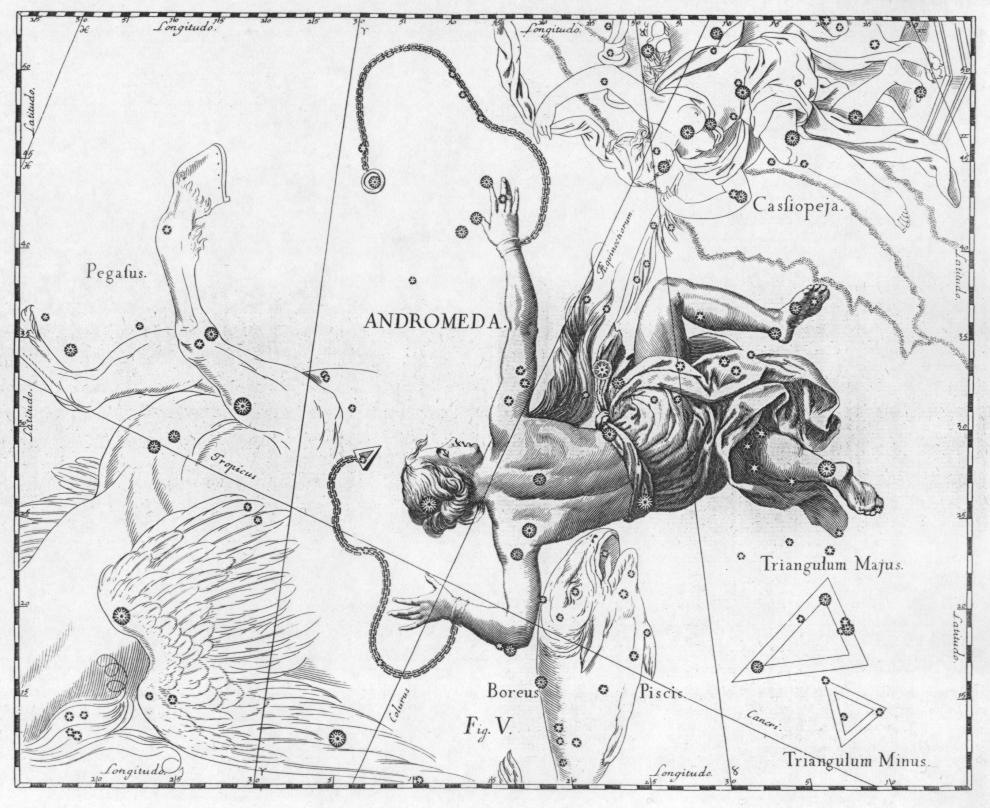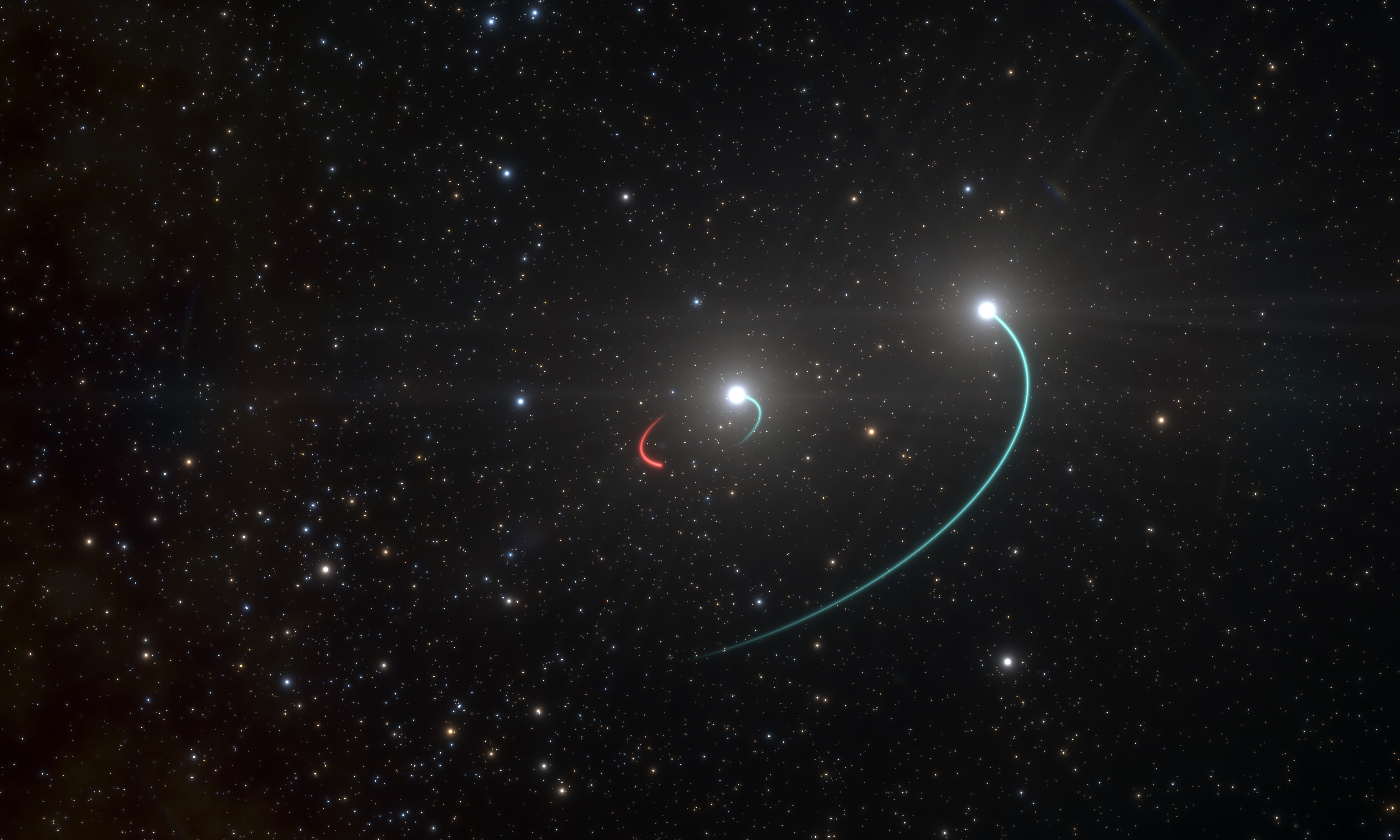|
Almach
Gamma Andromedae, Latinized from γ Andromedae, is the third-brightest point of light in the northern constellation of Andromeda. It is a multiple star system approximately 350 light-years from Earth. The system is drifting closer to the Sun with a radial velocity in the range of −12 to −14 km/s. Observation In 1778, German physicist Johann Tobias Mayer discovered that γ Andromedae is a double star. When examined in a small telescope, it appears to be a bright, golden-yellow star next to a dimmer, indigo-blue star, separated by approximately 10 arcseconds. The pair is often considered by stargazers to be a beautiful double star with a striking contrast of color. The brighter member, γ1 Andromedae, is the primary of the system, and is thus designated component γ Andromedae A. It has the official proper name Almach , which was used as the traditional name of the naked eye star, and thus the system as a whole. The fainter secondary is γ2 A ... [...More Info...] [...Related Items...] OR: [Wikipedia] [Google] [Baidu] |
Andromeda (constellation)
Andromeda is one of the 48 constellations listed by the 2nd-century Greco-Roman astronomer Ptolemy, and one of the 88 modern constellations. Located in the northern celestial hemisphere, it is named for Andromeda, daughter of Cassiopeia, in the Greek myth, who was chained to a rock to be eaten by the sea monster Cetus. Andromeda is most prominent during autumn evenings in the Northern Hemisphere, along with several other constellations named for characters in the Perseus myth. Because of its northern declination, Andromeda is visible only north of 40° south latitude; for observers farther south, it lies below the horizon. It is one of the largest constellations, with an area of 722 square degrees. This is over 1,400 times the size of the full moon, 55% of the size of the largest constellation, Hydra, and over 10 times the size of the smallest constellation, Crux. Its brightest star, Alpha Andromedae, is a binary star that has also been counted as a part of Pegasu ... [...More Info...] [...Related Items...] OR: [Wikipedia] [Google] [Baidu] |
List Of Stars In Andromeda
This is the list of notable stars in the constellation A constellation is an area on the celestial sphere in which a group of visible stars forms Asterism (astronomy), a perceived pattern or outline, typically representing an animal, mythological subject, or inanimate object. The origins of the e ... Andromeda, sorted by decreasing brightness. ; Notes: See also * List of stars by constellation References * * * * * * * * * * * * {{DEFAULTSORT:List of stars in Andromeda *List Andromeda ... [...More Info...] [...Related Items...] OR: [Wikipedia] [Google] [Baidu] |
J2000
In astronomy, an epoch or reference epoch is a moment in time used as a reference point for some time-varying astronomical quantity. It is useful for the celestial coordinates or orbital elements of a celestial body, as they are subject to perturbations and vary with time. These time-varying astronomical quantities might include, for example, the mean longitude or mean anomaly of a body, the node of its orbit relative to a reference plane, the direction of the apogee or aphelion of its orbit, or the size of the major axis of its orbit. The main use of astronomical quantities specified in this way is to calculate other relevant parameters of motion, in order to predict future positions and velocities. The applied tools of the disciplines of celestial mechanics or its subfield orbital mechanics (for predicting orbital paths and positions for bodies in motion under the gravitational effects of other bodies) can be used to generate an ephemeris, a table of values giving the positions ... [...More Info...] [...Related Items...] OR: [Wikipedia] [Google] [Baidu] |
Arabic
Arabic (, ' ; , ' or ) is a Semitic language spoken primarily across the Arab world.Semitic languages: an international handbook / edited by Stefan Weninger; in collaboration with Geoffrey Khan, Michael P. Streck, Janet C. E.Watson; Walter de Gruyter GmbH & Co. KG, Berlin/Boston, 2011. Having emerged in the 1st century, it is named after the Arab people; the term "Arab" was initially used to describe those living in the Arabian Peninsula, as perceived by geographers from ancient Greece. Since the 7th century, Arabic has been characterized by diglossia, with an opposition between a standard prestige language—i.e., Literary Arabic: Modern Standard Arabic (MSA) or Classical Arabic—and diverse vernacular varieties, which serve as mother tongues. Colloquial dialects vary significantly from MSA, impeding mutual intelligibility. MSA is only acquired through formal education and is not spoken natively. It is the language of literature, official documents, and formal writ ... [...More Info...] [...Related Items...] OR: [Wikipedia] [Google] [Baidu] |
Bayer Designation
A Bayer designation is a stellar designation in which a specific star is identified by a Greek or Latin letter followed by the genitive form of its parent constellation's Latin name. The original list of Bayer designations contained 1,564 stars. The brighter stars were assigned their first systematic names by the German astronomer Johann Bayer in 1603, in his star atlas '' Uranometria''. Bayer catalogued only a few stars too far south to be seen from Germany, but later astronomers (including Nicolas-Louis de Lacaille and Benjamin Apthorp Gould) supplemented Bayer's catalog with entries for southern constellations. Scheme Bayer assigned a lowercase Greek letter (alpha (α), beta (β), gamma (γ), etc.) or a Latin letter (A, b, c, etc.) to each star he catalogued, combined with the Latin name of the star's parent constellation in genitive (possessive) form. The constellation name is frequently abbreviated to a standard three-letter form. For example, Aldebaran in the constellation ... [...More Info...] [...Related Items...] OR: [Wikipedia] [Google] [Baidu] |
Star System
A star system or stellar system is a small number of stars that orbit each other, bound by gravitational attraction. A large group of stars bound by gravitation is generally called a '' star cluster'' or ''galaxy'', although, broadly speaking, they are also star systems. Star systems are not to be confused with planetary systems, which include planets and similar bodies (such as comets). A star system of two stars is known as a '' binary star'', ''binary star system'' or ''physical double star''. If there are no tidal effects, no perturbation from other forces, and no transfer of mass from one star to the other, such a system is stable, and both stars will trace out an elliptical orbit around the barycenter of the system indefinitely. ''(See Two-body problem)''. Examples of binary systems are Sirius, Procyon and Cygnus X-1, the last of which probably consists of a star and a black hole. Multiple star systems A multiple star system consists of three or more stars t ... [...More Info...] [...Related Items...] OR: [Wikipedia] [Google] [Baidu] |
International Astronomical Union
The International Astronomical Union (IAU; french: link=yes, Union astronomique internationale, UAI) is a nongovernmental organisation with the objective of advancing astronomy in all aspects, including promoting astronomical research, outreach, education, and development through global cooperation. It was founded in 1919 and is based in Paris, France. The IAU is composed of individual members, who include both professional astronomers and junior scientists, and national members, such as professional associations, national societies, or academic institutions. Individual members are organised into divisions, committees, and working groups centered on particular subdisciplines, subjects, or initiatives. As of 2018, the Union had over 13,700 individual members, spanning 90 countries, and 82 national members. Among the key activities of the IAU is serving as a forum for scientific conferences. It sponsors nine annual symposia and holds a triannual General Assembly that sets policy ... [...More Info...] [...Related Items...] OR: [Wikipedia] [Google] [Baidu] |
Working Group On Star Names
The International Astronomical Union (IAU) established a Working Group on Star Names (WGSN) in May 2016 to catalog and standardize List of proper names of stars, proper names for stars for the international astronomical community. It operates under Division C – Education, Outreach and Heritage. The IAU states that it is keen to make a distinction between the terms Stellar designations and names, ''name'' and ''designation''. To the IAU, ''name'' refers to the (usually colloquial) term used for a star in everyday conversation, while ''designation'' is solely alphanumerical, and used almost exclusively in official catalogues and for professional astronomy. (The WGSN notes that transliteration, transliterated Bayer designations (e.g., Tau Ceti) are considered a special historical case and are treated as designations.) Terms of reference The terms of reference for the WGSN for the period 2016–2018 were approved by the IAU Executive Committee at its meeting on 6 May 2016 ... [...More Info...] [...Related Items...] OR: [Wikipedia] [Google] [Baidu] |
Al Achsasi Al Mouakket
Muḥammad al-Akhṣāṣī al-Muwaqqit ( ar, محمد الاخصاصي الموقت) was an Egyptian astronomer whose and catalogue of stars, ('Pearls of brilliance upon the solar operations'), was written at Cairo about 1650. Al-Akhsasi was a shaykh, a learned elder, of the Grand Mosque of the university of Cairo, where his name ''al-Muwaqqit'' reflected his position regulating the times and hours at the mosque. His name Akhsasi connects him in origin to a village in the Faiyum, southwest of Cairo. No copies of his book were known to Western astronomers or historians of science The history of science covers the development of science from ancient history, ancient times to the present. It encompasses all three major branches of science: natural science, natural, social science, social, and formal science, formal. Sc ... until 1895;Knobel 1895. thus he did not appear in the standard French and English bibliographies and library catalogues of the 19th century. Notes { ... [...More Info...] [...Related Items...] OR: [Wikipedia] [Google] [Baidu] |
Caracal
The caracal (''Caracal caracal'') () is a medium-sized wild cat native to Africa, the Middle East, Central Asia, and arid areas of Pakistan and northwestern India. It is characterised by a robust build, long legs, a short face, long tufted ears, and long canine teeth. Its coat is uniformly reddish tan or sandy, while the ventral parts are lighter with small reddish markings. It reaches at the shoulder and weighs . It was first scientifically described by German naturalist Johann Christian Daniel von Schreber in 1776. Three subspecies are recognised. Typically nocturnal, the caracal is highly secretive and difficult to observe. It is territorial, and lives mainly alone or in pairs. The caracal is a carnivore that typically preys upon small mammals, birds, and rodents. It can leap higher than and catch birds in midair. It stalks its prey until it is within of it, after which it runs it down and kills its prey with a bite to the throat or to the back of the neck. Both sexe ... [...More Info...] [...Related Items...] OR: [Wikipedia] [Google] [Baidu] |
Triple Star System
A star system or stellar system is a small number of stars that orbit each other, bound by gravitational attraction. A large group of stars bound by gravitation is generally called a ''star cluster'' or ''galaxy'', although, broadly speaking, they are also star systems. Star systems are not to be confused with planetary systems, which include planets and similar bodies (such as comets). A star system of two stars is known as a ''binary star'', ''binary star system'' or ''physical double star''. If there are no tidal effects, no perturbation from other forces, and no transfer of mass from one star to the other, such a system is stable, and both stars will trace out an elliptical orbit around the barycenter of the system indefinitely. ''(See Two-body problem)''. Examples of binary systems are Sirius, Procyon and Cygnus X-1, the last of which probably consists of a star and a black hole. Multiple star systems A multiple star system consists of three or more stars that appear ... [...More Info...] [...Related Items...] OR: [Wikipedia] [Google] [Baidu] |






